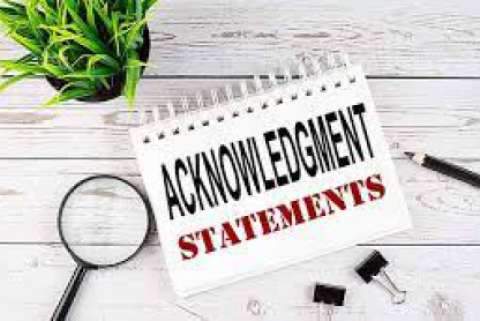Introduction
In the realm of customer service, acknowledgment statements play a pivotal role in setting the tone for positive interactions. These statements convey empathy, attentiveness, and a commitment to addressing customer needs. This article aims to provide a comprehensive guide on crafting effective acknowledgment statements, exploring their importance, key elements, and providing sample statements to enhance customer service interactions.
The Importance of Acknowledgment Statements
a. Building Customer Rapport
Acknowledgment statements serve as a foundational element in building rapport with customers. This section explores how a well-crafted acknowledgment can create a positive and empathetic customer experience.
b. Enhancing Communication
Effective communication is at the heart of acknowledgment statements. This section delves into how well-structured acknowledgments contribute to clear and open communication between service representatives and customers.
Key Elements of Effective Acknowledgment Statements
a. Empathy and Understanding
Acknowledgment statements should convey genuine empathy and understanding of the customer's situation. This section explores how to infuse empathy into statements for a more meaningful connection.
b. Clarity and Transparency
Clear and transparent communication is essential. This section discusses how acknowledgment statements can set the stage for transparent discussions, building trust between customers and service representatives.
Sample Acknoledgment Statements for Various Situations
a. Service Delays or Issue
Sample acknowledgment statements for situations where there are service delays or issues, demonstrating accountability and a commitment to resolution.
b. Customer Complaints
Crafting acknowledgment statements for customer complaints, emphasizing the acknowledgment of concerns and outlining steps for resolution.
c. Product Defects or Quality Issues
Sample statements addressing product defects or quality issues, showcasing a proactive approach to resolving problems and ensuring customer satisfaction.
d. Expressing Gratitude
Acknowledgment statements expressing gratitude for customer loyalty, feedback, or positive experiences, fostering a sense of appreciation and connection.
Tailoring Acknowledgment Statements to Different Channels
a. Phone Conversations
Tips on crafting effective acknowledgment statements during phone conversations, considering tone, pacing, and verbal cues.
b. Live Chat Interactions
Sample acknowledgment statements suitable for live chat interactions, where concise and clear communication is key.
c. Email Correspondence
Crafting acknowledgment statements for email correspondence, emphasizing the importance of clarity and professionalism in written communication.
Acknowledgment Statements in Challenging Situations
a. Handling Emotional Customers
Tips and sample statements for acknowledging and managing interactions with emotional or upset customers, emphasizing empathy and resolution.
b.Navigating Language Barriers
Acknowledgment statements that are culturally sensitive and effective in situations involving language barriers, ensuring clear communication and understanding.
Training and Implementing Acknowledgment Statements
a. Employee Training
Strategies for training customer service representatives in the art of crafting and delivering effective acknowledgment statements, emphasizing the importance of active listening and empathy.
b. Consistency Across Teams
Ensuring consistency in acknowledgment statements across different teams and representatives, contributing to a unified and positive customer experience.
Measuring the Impact of Acknowledgment Statements
a. Customer Satisfaction Metrics
Analyzing the impact of acknowledgment statements on customer satisfaction metrics, including tips on gathering feedback and making improvements.
b. Employee Performance Metrics
Assessing the effectiveness of acknowledgment statements through employee performance metrics, recognizing and rewarding exemplary customer service.
Technological Solutions for Implementing Acknowledgment Statements
a. CRM Integration
Leveraging Customer Relationship Management (CRM) tools to integrate acknowledgment statements into customer interactions, streamlining communication processes.
b. AI-driven Support
Exploring the role of artificial intelligence (AI) in enhancing acknowledgment statements, including chatbots and virtual assistants to provide immediate and consistent responses.
Future Trends in Acknowledgment Statements
a. Personalization and Customization
Anticipating future trends in acknowledgment statements, including the growing importance of personalization and customization to meet evolving customer expectations.
b. Multilingual Support
Considering the integration of multilingual acknowledgment statements to cater to diverse customer bases, reflecting a commitment to inclusivity.
Conclusion
In conclusion, acknowledgment statements are a fundamental aspect of customer service interactions, shaping the overall customer experience. Crafting effective statements requires a blend of empathy, clarity, and adaptability to different situations and channels. By embracing best practices, providing training, and leveraging technological solutions, businesses can ensure that acknowledgment statements become a powerful tool in building positive relationships and fostering customer loyalty in an ever-evolving service landscape.



